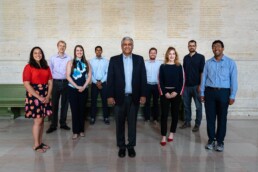Smart systems for semiconductor manufacturing
Lam Research Tech Symposium, co-hosted by MIT.nano and Microsystems Technology Lab, explores challenges, opportunities for the future of the industry.
Integrating smart systems into manufacturing offers the potential to transform many industries. Lam Research, a founding member of the MIT.nano Consortium and a longtime member of the Microsystems Technology Lab (MTL) Microsystems Industrial Group, explored the challenges and opportunities smart systems bring to the semiconductor industry at its annual technical symposium, held at MIT in October.
Co-hosted by MIT.nano and the MTL, the two-day event brought together Lam’s global technical staff, academic collaborators, and industry leaders with MIT faculty, students, and researchers to focus on software and hardware needed for smart manufacturing and process controls.
Tim Archer, president and CEO of Lam Research, kicked off the first day, noting that “the semiconductor industry is more impactful to people's lives than ever before."
Students spearhead group to enhance the graduate experience
School of Engineering advisory group proposes a new leadership curriculum and stronger student-advisor relationships.
What do graduate students in engineering want?
This was the question before a new advisory group launched by the MIT School of Engineering in late 2017 — the school’s first comprised entirely of graduate students. This fall the group is rolling out its inaugural initiatives: a graduate-level leadership minor or certificate and a set of recommendations intended to improve advisor-advisee relations.
GradSAGE (short for Graduate Student Advisory Group for Engineering) was established by Anantha Chandrakasan just months after he became dean of the MIT School of Engineering.
“I thought it would be great to get student engagement as we shaped new initiatives, and to learn their perspectives on important issues and challenges they face,” says Chandrakasan. “In a sense, we are listening to our customers.”
The dean already counted department heads and other school stakeholders among his advisors. But Chandrakasan, the Vannevar Bush Professor of Electrical Engineering and Computer Science, felt he was missing the voice of students.
MIT engineers build advanced microprocessor out of carbon nanotubes
The microprocessor, described today in the journal Nature, can be built using traditional silicon-chip fabrication processes, representing a major step toward making carbon nanotube microprocessors more practical.
Silicon transistors — critical microprocessor components that switch between 1 and 0 bits to carry out computations — have carried the computer industry for decades. As predicted by Moore’s Law, industry has been able to shrink down and cram more transistors onto chips every couple of years to help carry out increasingly complex computations. But experts now foresee a time when silicon transistors will stop shrinking, and become increasingly inefficient.
MIT engineers design a system for IoT chips to do quantum-computer-proof encryption.
MIT engineers design a system for IoT chips to do quantum-computer-proof encryption
One of the most frequently mentioned fears about future quantum computers is that they will someday crack our encryption codes and lay all our digital secrets bare. Despite it being a truly far-off possibility, cryptographers are already taking the threat very seriously.
The solution seems to be to develop one or more classes of encryption schemes that classical computers can use but quantum computers can’t crack. Less than two weeks ago, the U.S. National Institute of Standards and Technology reported that its search for quantum-proof algorithms had reached the semifinals stage. Following a year-long evaluation, the agency has narrowed the field down to 26 algorithms, most of which fall into three broad families.
Now, at the IEEE International Solid-State Circuits Conference on Monday in San Francisco, engineers from MIT have reported the creation of an encryption system that performs one of these schemes on a chip small enough and energy-efficient enough to guard battery-powered nodes on the Internet of Things from future quantum attack.



